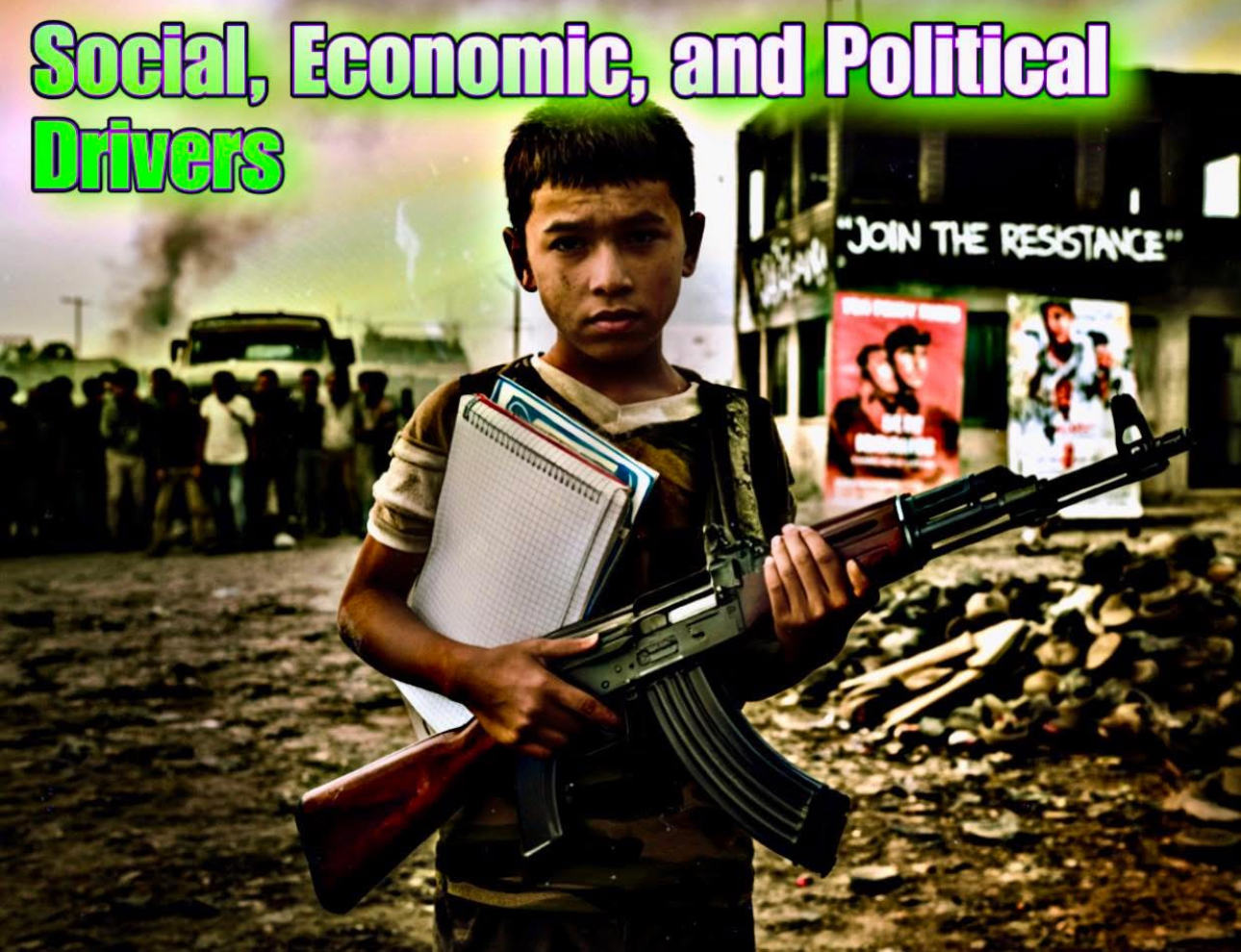Child soldiering is rarely the result of a single factor. Instead, it emerges from a convergence of vulnerabilities, each one compounding the next until the child is no longer protected by family, community, or nation. In the vast majority of cases, recruitment does not begin with ideology or coercion, but with the erosion of basic societal order. At the heart of this tragedy lies a harsh truth: where fathers are absent, borders are broken, and governments fail to uphold justice, children are left to fend for themselves, and predators always fill the vacuum. Poverty remains the most consistent and global driver of child recruitment. In economically collapsed regions, whether the jungles of Colombia, the urban ruins of Aleppo, or the refugee camps of Sudan, young people often join armed groups not out of conviction, but out of survival. Food, shelter, and a semblance of identity are often promised by warlords or militant recruiters, and for children with no prospects or guardians, the offer becomes seductively logical. Armed groups frequently provide uniforms, meals, small salaries, and even a kind of brotherhood, while government institutions offer nothing. This form of transactional recruitment does not excuse exploitation, but it exposes the broader failure of national and international systems to meet the most basic needs of children in war zones. Orphanhood and family breakdown are deeply tied to this vulnerability. Children who lose parents to war, famine, disease, or political purges are exponentially more likely to be recruited. In many cultures, the extended family or tribal system once served as a safety net, but globalization, migration, and civil war have shredded these systems. Without father figures, children, particularly boys, gravitate toward militant men who project power, control, and order, however violent. This is especially true in places like Burkina Faso, Gaza, and northeast Nigeria, where the death or disappearance of adult men has created a vacuum filled by jihadist leaders or gang lords posing as protectors. The loss of patriarchy, properly understood as moral and sacrificial leadership, is a critical but under-acknowledged enabler of child soldiering. Displacement, both internal and cross-border, also accelerates recruitment. As of mid-2025, over 46 million children globally are living as displaced persons, many in makeshift camps with little schooling, supervision, or access to future employment. Armed groups often patrol these camps, identifying disoriented boys and girls who can be lured, indoctrinated, or taken by force. In regions like the Sahel and eastern DRC, there is overwhelming evidence that child recruitment spikes in the months following large-scale displacement events, especially when international organizations are slow to respond or limited by bureaucratic mandates. Ideological indoctrination is another powerful vector, particularly in conflicts driven by radical political or religious agendas. Militant Islamism, Marxist revolutionism, and ethno-nationalist zeal have all proven capable of reengineering childhood itself. In groups like Boko Haram, the Taliban, ISIS, and Colombian FARC remnants, children are not merely recruited as fighters, they are transformed into instruments of ideology, often forced to chant slogans, memorize creeds, or carry out executions to sever ties with innocence and humanity. Girls are subjected to forced marriages and taught submission as a spiritual obligation, while boys are taught martyrdom, vengeance, and obedience as virtues. In these cases, the battlefield is not only external, it is the child’s conscience. Peer pressure and group dynamics also play a disturbing role. In many contexts, children join because their friends, cousins, or classmates have already done so. Recruiters exploit this, creating a sense of “belonging” that replaces the fractured bonds of family and community. Those who resist are often labeled weak or traitorous, and in areas where schools have closed or been destroyed, the armed group becomes the only institution offering identity and purpose. Tragically, children may even view joining a militant group as a rite of passage into adulthood, particularly where no other path to manhood or honor exists. Finally, and most terribly, state collapse removes all natural barriers to child exploitation. In functioning societies, police, courts, educators, and social workers form a protective perimeter around youth. In failed states like Haiti, Somalia, Yemen, or newly collapsing South Sudan, these systems are either absent, corrupt, or complicit in abuse. Even the presence of international actors often proves insufficient when there is no legitimate government to enforce justice. Where no one governs, those with guns do, and they govern children the same way they govern territory. Through fear and force. Child soldiering, therefore, must not be viewed simply as a humanitarian crisis, but as a moral indictment of failed states and broken institutions. Every child with a rifle is a visible symbol of a collapsed order. Solving this epidemic will not come from sentiment or slogans, but from rebuilding families, restoring local justice, and denying armed groups access to the vulnerable. Until then, we must stop pretending these children were simply kidnapped. In truth, they were abandoned first.

